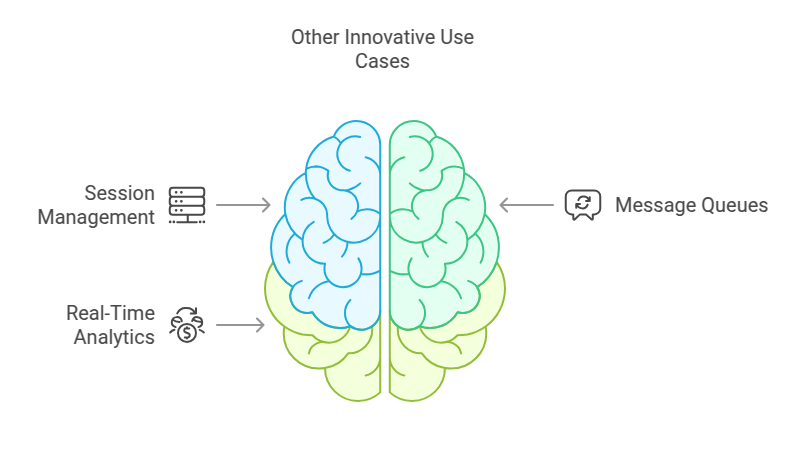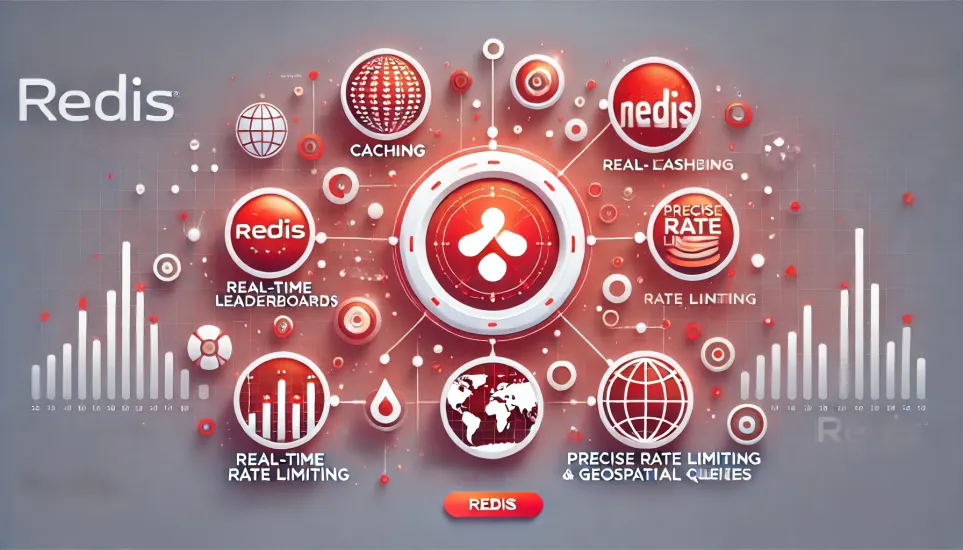When you hear “Redis,” you might think of blazing-fast caching solutions. While Redis excels at caching, its versatile data structures and rich feature set make it a powerful tool for much more. Modern applications are leveraging Redis for innovative use cases such as real-time leaderboards, precise rate limiting, and even complex geospatial queries.
In this blog, we’ll dive into these less-common but incredibly impactful applications of Redis, demonstrating why it’s more than “just a cache.”
1. Building Real-Time Leaderboards
Why Redis?
The Problem: Keeping Real-Time Leaderboards
Imagine you’re playing a competitive online game or tracking your daily steps on a fitness app. Wouldn’t it be annoying if the leaderboard didn’t update instantly as you scored points or walked more steps? In these scenarios, real-time leaderboards are essential.
Here’s the challenge:
- The leaderboard needs to keep all the users ranked by their scores or stats (like game points or step counts).
- It must update rankings instantly when someone’s score changes.
- It should allow quick lookups, like finding the top 10 players or your current rank.
Doing this in traditional databases can be slow and complex, especially when millions of users are playing or competing simultaneously. This is where Redis and its Sorted Sets shine.
How It Works
- Sorted Sets store unique elements, each assigned a score that determines its rank. For example, a player's username can be the element, and their score is the ranking criteria.
- Commands like
ZADD,ZRANGE, andZREVRANKhelp in adding scores, fetching top-ranked players, and determining user ranks dynamically.
Example with Golang
Let’s build a leaderboard for a multiplayer game in Golang:
package main
import (
"github.com/go-redis/redis/v8"
"context"
"fmt"
)
func main() {
ctx := context.Background()
rdb := redis.NewClient(&redis.Options{
Addr: "localhost:6379",
})
// Add players and their scores
rdb.ZAdd(ctx, "game_leaderboard", &redis.Z{Score: 1000, Member: "player1"})
rdb.ZAdd(ctx, "game_leaderboard", &redis.Z{Score: 2000, Member: "player2"})
// Fetch top 10 players
topPlayers, _ := rdb.ZRevRangeWithScores(ctx, "game_leaderboard", 0, 9).Result()
fmt.Println("Top Players:")
for _, player := range topPlayers {
fmt.Printf("Player: %v, Score: %v\n", player.Member, player.Score)
}
}
This program dynamically updates and retrieves the leaderboard from Redis.
2. Precise Rate Limiting for APIs
Why Redis?
When you build an API or a service, you often face a big challenge: how to prevent users (or bots) from sending too many requests in a short period. Imagine an e-commerce website during a big sale — if everyone (or even a few bots) bombards the server with requests, the website could slow down or even crash. Its simplicity ensures low-latency enforcement even for high-traffic APIs. To keep things running smoothly, we use a mechanism called rate limiting.
Why Redis is Great for Rate Limiting
TTL (Time to Live): Redis can automatically set an expiration time on any key. This is like saying, “I’ll remember how many requests you’ve made, but I’ll forget them after a minute.”
Example: If a user sends 5 requests within 60 seconds, Redis tracks this. Once 60 seconds pass, Redis resets the count back to 0.
Atomic Operations: Redis ensures that all the commands you run (like increasing the request count) happen in one go. This means there’s no room for mix-ups, even when hundreds of users are hitting the server at the same time.
Example: Think of it as a super-efficient cashier who processes your payment in one seamless step, no matter how long the line is.
- Low Latency: Redis operates entirely in memory, so it’s lightning-fast. For APIs that handle millions of requests per second, speed is critical. Redis doesn’t slow things down — it just keeps the flow under control.
Common Patterns
- Fixed Window Rate Limiting: Count requests within a fixed time window by setting keys with expiration.
- Sliding Window Rate Limiting: Use Redis Sorted Sets to track precise request timestamps.
Example with Golang
Let’s implement fixed window rate limiting in Golang:
package main
import (
"github.com/go-redis/redis/v8"
"context"
"fmt"
)
func rateLimit(ctx context.Context, rdb *redis.Client, userKey string, limit int, expireSeconds int) bool {
count, _ := rdb.Incr(ctx, userKey).Result()
if count == 1 {
rdb.Expire(ctx, userKey, time.Duration(expireSeconds)*time.Second)
}
if int(count) > limit {
return false
}
return true
}
func main() {
ctx := context.Background()
rdb := redis.NewClient(&redis.Options{
Addr: "localhost:6379",
})
userKey := "user123:requests"
limit := 10
expireSeconds := 60
if rateLimit(ctx, rdb, userKey, limit, expireSeconds) {
fmt.Println("Request allowed!")
} else {
fmt.Println("Rate limit exceeded!")
}
}
This code tracks and limits user requests to 10 per minute.
3. Exploring the World with Geospatial Queries
Why Redis?
Redis’s GEO commands enable it to act as a lightweight geospatial database. You can store, query, and analyze location data effortlessly. It’s ideal for delivery apps, ride-sharing services, or location-based promotions.
Let’s dive into this one with a practical, relatable perspective. 🚗📍
The Problem: Location-Based Features
Imagine you’re using a delivery app, booking a ride-share, or looking for nearby discount offers. For these use cases, apps need to:
- Store locations (e.g., restaurant addresses, drivers, or store locations).
- Find locations nearby (e.g., “Which drivers are within 5 km of me?” or “What’s the closest pizza place?”).
- Do all of this quickly and efficiently, even when there are thousands (or millions) of location points.
Building this with a traditional database can be slow and resource-heavy, especially for real-time queries. Redis’s GEO commands step in to solve this with speed and simplicity.
How It Works
- Use
GEOADDto add latitude, longitude, and place names. - Commands like
GEORADIUSorGEOSEARCHfind locations within a specific area.
Example with Golang
Here’s how to find nearby locations:
package main
import (
"github.com/go-redis/redis/v8"
"context"
"fmt"
)
func main() {
ctx := context.Background()
rdb := redis.NewClient(&redis.Options{
Addr: "localhost:6379",
})
// Add locations
rdb.GeoAdd(ctx, "restaurants", &redis.GeoLocation{Longitude: 13.361389, Latitude: 38.115556, Name: "Sicilian Pizza"})
rdb.GeoAdd(ctx, "restaurants", &redis.GeoLocation{Longitude: 15.087269, Latitude: 37.502669, Name: "Pasta House"})
// Search nearby
results, _ := rdb.GeoRadius(ctx, "restaurants", 15, 37, &redis.GeoRadiusQuery{
Radius: 5,
Unit: "km",
WithCoord: true,
WithDist: true,
}).Result()
for _, location := range results {
fmt.Printf("Name: %s, Distance: %.2f km\n", location.Name, location.Dist)
}
}
This program finds restaurants within 5 kilometers.
Redis: More Than a Database
Redis’s versatility doesn’t stop here. Other innovative use cases include:
- Session Management: Store and retrieve session data with minimal latency.
- Message Queues: Use Redis’s Lists and Pub/Sub for lightweight messaging systems.
- Real-Time Analytics: Track metrics like active users or transaction counts in real-time.

Stay tuned for more detailed examples and use cases in upcoming blogs. Redis truly is more than a database—it’s a powerhouse for building modern, high-performance applications.
Final Thoughts
Redis has come a long way from being just a caching solution. Its unique data structures and advanced features empower developers to tackle a wide range of challenges, from building engaging user experiences with real-time leaderboards to ensuring smooth API performance with rate limiting.
If you’re already using Redis for caching, it’s time to unleash its full potential. Whether you’re building the next big social app, a seamless API, or a location-based service, Redis has the tools to make it happen.
Ready to rediscover Redis?
Share your unique Redis use cases or let’s connect here to explore new ways to leverage this powerhouse!






